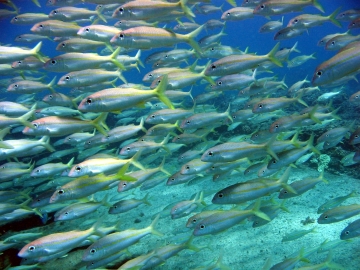SATS print 230_360 px width.jpg

Schools of fish expend less energy swimming as a group than as individuals. Credit: Dr. Dwayne Meadows, NOAA/NMFS/OPR
During bicycling races, cyclists often ride close together to take advantage of drafting, where a low-pressure area created behind a cyclist gives a boost to the one following them so the whole group can expend less energy. While the dynamics of ocean currents underwater are a bit different from air currents, it turns out that a similar strategy can help fish in turbulent water. New research has revealed that fish can swim far more easily, and use much less energy, swimming together in a school than battling the currents on their own.
Scientists conducted experiments with giant danios, a popular species for tropical aquariums whose natural habitat is streams and rivers in India. The scientists used high-speed cameras to observe the fish’s movements as they swam. They saw that the fish pressed more closely together in their school when the water was more turbulent, and fish swimming by themselves had to swim more vigorously just to keep up with the school.
The biologists also used devices called respirometers to measure the breathing rates and energy expenditure of the fish. They discovered that fish in turbulent water used up to 79% less energy when they swam in schools compared to swimming on their own. That’s even more impressive than the 40% less energy that cyclists use when drafting in road cycling. The findings suggest that traveling in schools offers more than just protection from predators. It’s also a more efficient way to travel through the water, particularly when currents pick up. And, more surprisingly, other research has found it’s also a quieter way to travel. When schooling fish synchronize their swimming, even a group of them sounds like no more than a single fish.


